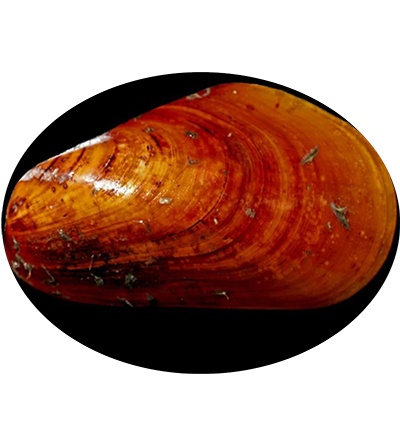
Gigantidas platifrons is a deep-sea mussel that is common in hydrothermal vents and methane seeps in the Western Pacific Ocean. It is found in hydrothermal vents in the Okinawa Trough and cold seeps in Sagami Bay (Japan) and the South China Sea. Morever, it harbours methane-oxidizing bacteria in its gill, which help to transfer methane into material and energy to help it to thrive in such environments.
Animalia (Kingdom); Mollusca (Phylum); Bivalvia (Class); Autobranchia (Subclass); Pteriomorphia (Infraclass); Mytilida (Order); Mytiloidea (Superfamily); Modiolidae (Family); Bathymodiolinae (Subfamily); Gigantidas (Genus); Gigantidas platifrons (Species)
Bathymodiolus platifrons Hashimoto & Okutani, 1994
1. Hashimoto J, Okutani T. Four new mytilid mussels associated with deepsea chemosynthetic communities around Japan[J]. Venus (Japanese Journal of Malacology), 1994, 53(2): 61-83. (Hashimoto et al., 1994)
Shell large, up to 115 mm long, rather thick and solid, inflated,modioliform, oblong rounded-triangular in lateralview, equivalve, inequilateral,heightllengthratio O.50-O.68, width/length ratio O.34-O.47. Umbones prosogyrated, often nearly subterminal, but mostly on the same plane with anterior end of the shell. Umbonal ridge prominent. Anterior end rounded, dorsalmargin slightly convex, postero-dorsal corner round, postero-dorsal margin slightly convex, posterior margin broadly rounded, ventral margin slightly concave or nearly straight, External surface smooth, dull white beneath periostracum, with fine growth linesin juvenileand subadult, but with developed irregularlyspaced growth lirae in adults. Periostracum yellow in juvenileand subadult specimens, but usually yellowish straw, yellow-brown or dark brown in adult specimens, or dark russet in.some specimens. No periostracalhairs present.
Ptati means flatand .frons forehead. Because of rather truncated appearance in frontal region of the shell, the name was chosen.
Okinoyama Bank and off Hatsushima Sitein Sagami Bay, the Iheya Ridge and the Izena Caldron in the mid-Okinawa Trough, The specimens attached to outcrops with byssus around diffused vents
| Species | Phylum | Common Name | Ecosystem | Depth | Habitat | NCBI Taxonomy ID |
|---|---|---|---|---|---|---|
| Gigantidas platifrons | Mollusca | cold seep mussel, Bathymodiolus platifrons | Cold seep/Hydrothermal vent | 1,122-1,430 | methane seep (22° 06.921′ N, 119° 17.131′ E) in the South China Sea | 2830794 |
| Genome Assembly | Genome Size | Assembly level | Released year | WGS accession | Submitter | BioProject | BUSCO completeness (%) | Scaffold/Contig N50 (kb) | GC content (%) | Repeat Rate (%) | Gene Number |
|---|---|---|---|---|---|---|---|---|---|---|---|
| Bpl_v1.0 | 1.64Gb | Scaffold | 2017 | MJUT01 | Hong Kong University of Science and Technology | PRJNA328542 | 96.30 | 343.3/12.6 | 34.3 | 47.93 | 33,584 |
| Title | Journal | Pubmed ID |
|---|---|---|
| Adaptation to deep-sea chemosynthetic environments as revealed by mussel genomes | Nature Ecology & Evolution | 28812709 |
| Gene ID | Description |
|---|---|
| Bpl_scaf_23346-4.9 | PROTEASE S28 PRO-X CARBOXYPEPTIDASE-RELATED |
| Bpl_scaf_23346-5.13 | STIMULATOR OF INTERFERON GENES PROTEIN |
| Bpl_scaf_23346-5.16 | STIMULATOR OF INTERFERON GENES PROTEIN |
| Bpl_scaf_23359-0.3 | FIBRINOGEN/TENASCIN/ANGIOPOEITIN |
| Bpl_scaf_23359-0.4 | FIBRINOGEN/TENASCIN/ANGIOPOEITIN |
| Bpl_scaf_23382-0.6 | PROPERDIN |
| Bpl_scaf_23397-0.4 | M-PHASE INDUCER PHOSPHATASE DUAL SPECIFICITY PHOSPHATASE CDC25 |
| Bpl_scaf_23397-0.5 | G PROTEIN-COUPLED RECEPTOR |
| Bpl_scaf_23397-0.6 | UNCHARACTERIZED |
| Bpl_scaf_23397-0.9 | M-PHASE INDUCER PHOSPHATASE DUAL SPECIFICITY PHOSPHATASE CDC25 |
| Bpl_scaf_23410-0.23 | - |
| Bpl_scaf_23410-0.24 | - |
| Bpl_scaf_23410-0.25 | - |
| Bpl_scaf_23417-0.3 | ANKYRIN REPEAT DOMAIN 40 |
| Bpl_scaf_23417-0.6 | DRAB11-RELATED |
| Bpl_scaf_23417-0.8 | RIBOFLAVIN KINASE/FMN ADENYLYLTRANSFERASE |
| Bpl_scaf_2342-0.1 | T-SNARE COILED-COIL HOMOLOGY DOMAIN-CONTAINING PROTEIN |
| Bpl_scaf_2342-0.2 | - |
| Bpl_scaf_2342-0.4 | ULP_PROTEASE DOMAIN-CONTAINING PROTEIN |
| Bpl_scaf_2342-0.5 | - |
| Annotation ID | Description | Type | Subtype | GeneRatio | Evolution Type | P-value | Q-value |
|---|---|---|---|---|---|---|---|
| PF13927.3 | Immunoglobulin domain | Pfam | - | 830 | expanded | 3.94E-63 | 6.33E-59 |
| PF07679.13 | Immunoglobulin I-set domain | Pfam | - | 746 | expanded | 1.92E-54 | 1.54E-50 |
| PF00047.22 | Immunoglobulin domain | Pfam | - | 677 | expanded | 1.58E-47 | 8.47E-44 |
| PF07686.14 | Immunoglobulin V-set domain | Pfam | - | 605 | expanded | 2.02E-41 | 8.14E-38 |
| PF13895.3 | Immunoglobulin domain | Pfam | - | 603 | expanded | 4.02E-36 | 1.29E-32 |
| PF00386.18 | C1q domain | Pfam | - | 415 | expanded | 6.37E-36 | 1.71E-32 |
| PF16095.2 | C-terminal of Roc, COR, domain | Pfam | - | 175 | expanded | 1.92E-27 | 3.42E-24 |
| PF00102.24 | Protein-tyrosine phosphatase | Pfam | - | 276 | expanded | 6.01E-20 | 6.91E-17 |
| PF13472.3 | GDSL-like Lipase/Acylhydrolase family | Pfam | - | 176 | expanded | 9.54E-18 | 9.03E-15 |
| PF16026.2 | zinc knuckle | Pfam | - | 137 | expanded | 4.83E-17 | 4.09E-14 |
| PF16680.2 | T-cell surface glycoprotein CD3 delta chain | Pfam | - | 169 | expanded | 2.07E-16 | 1.67E-13 |
| PF00012.17 | Hsp70 protein | Pfam | - | 179 | expanded | 1.01E-15 | 6.75E-13 |
| PF16706.2 | Izumo-like Immunoglobulin domain | Pfam | - | 216 | expanded | 5.56E-14 | 3.19E-11 |
| PF08205.9 | CD80-like C2-set immunoglobulin domain | Pfam | - | 266 | expanded | 7.72E-14 | 4.28E-11 |
| PF13936.3 | Helix-turn-helix domain | Pfam | - | 90 | expanded | 4.14E-13 | 2.15E-10 |
| PF13565.3 | Homeodomain-like domain | Pfam | - | 87 | expanded | 5.96E-12 | 2.59E-09 |
| PF07654.12 | Immunoglobulin C1-set domain | Pfam | - | 170 | expanded | 1.39E-11 | 5.30E-09 |
| PF02796.12 | Helix-turn-helix domain of resolvase | Pfam | - | 73 | expanded | 1.52E-10 | 5.10E-08 |
| PF00653.18 | Inhibitor of Apoptosis domain | Pfam | - | 130 | expanded | 1.79E-10 | 5.86E-08 |
| PF12012.5 | Domain of unknown function (DUF3504) | Pfam | - | 106 | expanded | 2.00E-10 | 6.43E-08 |

